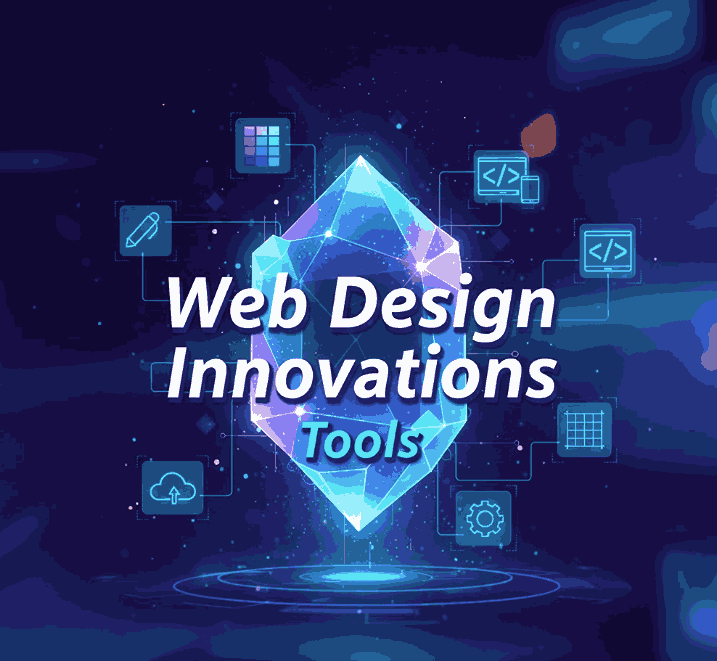
Table of Contents
- Introduction: Why Innovation Matters in Web Design
- Key Trends Driving Web Design in 2024–2025
- 2.1 AI & Machine Learning in Design
- 2.2 Dark Mode, Fluid Layouts & Accessibility
- 2.3 Microinteractions, Motion & Animation
- 2.4 Bold Typography & Experimental Fonts
- 2.5 3D, Immersive & WebXR Elements
- 2.6 No-code / Low-code & Generative Design
- Tools Powering These Innovations
- 3.1 Figma & AI-augmented design features
- 3.2 Webflow, Framer & visual dev platforms
- 3.3 Spline, Three.js & 3D / WebXR tools
- 3.4 Tools for Microinteractions & Animation
- 3.5 No-code / generative tools & AI assistants
- How Font Designers Can Ride the Trend Wave
- Mockup Examples with Our Fonts
- Tips to Stay Ahead in Web Design Innovation
- Conclusion & Call to Action
- References
1. Introduction: Why Matters in Web Design Innovations Tools
Web design is not static — it evolves with technology, user expectations, and creative exploration. The phrase web design innovations tools trends isn’t just buzzwords — it’s the lifeline for designers who want to stay relevant, efficient, and compelling.
For a site selling fonts and design assets (like yours), aligning your visual language, tools, and mockups with modern web trends is not optional — it’s strategic. In this article, we dive into the trends shaping 2024–2025, the tools enabling them, and how you as a font designer can integrate them into your visual offerings.

2. Key Trends Driving Web Design in 2024–2025
2.1 AI & Machine Learning in Web Design Innovations Tools
AI is no longer future speak — it’s here. Tools now generate images, themes, layouts, captions, and even micro-animations. Web design is shifting toward AI-assisted workflows that speed iteration and spark creativity.
Adaptive interfaces, personalized content, predictive UI elements — these are becoming integral as websites become more context-aware.
2.2 Dark Mode, Fluid Layouts & Accessibility
Dark mode continues its surge due to eye comfort, energy savings, and aesthetic appeal.
Another core movement is toward fluid layouts — sites that don’t rely on rigid breakpoints but scale proportionally across devices.
Accessibility is also front and center: inclusive color contrast, keyboard navigation, alt text, and responsive design — designers are treating it as fundamental, not optional.
2.3 Microinteractions, Motion & Animation
Subtle animations, hover effects, scroll transitions, cursor trails, loading micro-animations — these small touches bring delight and engagement. Innovation lies in making them lightweight, intuitive, and purposeful.
Also, textual animations and expressive transitions are rising, especially when typography is central in your design.
2.4 Bold Typography & Experimental Fonts
Typography is reclaiming its power in web design. Bold, expressive, variable fonts, kinetic type, layered type effects — all part of the trend to make text the hero.
In this context, font creators and sellers have a golden opportunity: offering fonts designed for web use (variable fonts, WOFF2), paired with innovative layouts, gives your customers creative edge.
2.5 3D, Immersive & WebXR Elements
The line between 2D websites and immersive experiences is blurring. Tools like Spline, Three.js, WebXR allow embedding 3D models, interactive scenes, or parallax spaces directly in the browser — without heavy plugins.
When used sparingly, 3D elements can enhance storytelling, product demos, or hero sections — if they’re performant and optimized.
2.6 No-code / Low-code & Generative Web Design Innovations Tools
Designers increasingly leverage visual dev platforms to skip manual coding. Webflow, Framer, Wix Studio, and others let you build with visual tools but output production-ready code.
Generative design tools help automatically generate layouts, themes, or variations — this trend accelerates experimentation. Paired with AI, you can iterate fast and test design hypotheses in minutes.
3. Tools Powering These Web Design Innovations Tools
Here are some tools at the forefront of the web design innovations tools trends:
3.1 Figma & AI-augmented design features
Figma remains central in collaborative UI/UX design. Its evolving support for AI agents, plugin ecosystem, and design systems make it a hub for experimentation.
3.2 Webflow, Framer & Visual Dev Platforms
Webflow merges visual design with code, enabling designers to build full websites. Framer extends interactive and animation capabilities.
3.3 Spline, Three.js & 3D / WebXR Tools
For immersive, 3D experiences in the browser, Spline is gaining ground as a designer-friendly 3D platform. Three.js is a powerful JavaScript library for custom 3D interactions.
3.4 Tools for Microinteractions & Animation
Tools and libraries like Lottie, GSAP, Motion One, Framer Motion help designers add performant animations. These integrate seamlessly with modern frameworks and visual tools.
3.5 No-code / Generative Tools & AI Assistants
Builder tools that accept design prompts and output websites (or UI kits) are trending. Platforms like Relume, Readymag, Pineapple Builder (AI-based) exemplify the shift toward prompt-to-site workflows.
4. How Font Designers Can Ride the Trend Wave
As someone running a font business, here’s how you can align with web design innovations:
- Offer Web-optimized font formats: variable fonts, WOFF2, etc.
- Showcase fonts in new contexts: 3D, immersive, dark mode, motion typography.
- Create mockups tailored to modern trends: microanimation, hover effects, interactive samples.
- Bundle trends-based templates: e.g. Webflow + font, Figma UI kits.
- Educate customers: show tutorials or demos of your fonts in trending web designs.

5. Mockup Examples with Our Fonts
To illustrate how your fonts can shine in modern web designs, here are some examples you can build mockups for:
- Aeromove Font — Use in bold, dynamic headers or hero text with subtle motion.
- Technophile Font — Great for futuristic, tech-themed layouts with 3D or neon accents.
- Holters Font — Good for bold statements, overlays, or title layers in immersive scenes.
- Catcalling Font — A more expressive or stylized font, suited to creative or fashion web themes.
You can combine these fonts in mockups that show hover reveals, animated type, dark mode toggles, or 3D elements — demonstrating to clients how they behave in next-gen web contexts.
6. Tips to Stay Ahead in Web Design Innovations Tools
- Follow trend reports (e.g. from Elementor, Hostinger) to spot shifts early.
- Prototype fast & test — use no-code tools to explore new ideas before heavy dev.
- Optimize performance first — fancy animations shouldn’t slow your site.
- Stay accessible — always maintain contrast, navigation clarity, and keyboard usability.
- Offer evolving mockups — update your font demo pages to reflect current trends.
7. Conclusion & Call to Action Web Design Innovations Tools
Web design innovations tools trends are reshaping how we build, deliver, and experience the web. For designers and font vendors, these shifts offer opportunity — if you adapt. By combining modern tools, immersive elements, motion, and bold typography, you make your fonts relevant in the next era of digital design.
Call to Action: Jika kamu mau, saya bisa bantu buat mockup template web (Figma/Webflow) dengan fontmu agar bisa langsung dipakai oleh klien. Mau saya bantu susun?
8. References
- Muzli — Exploring Top Web Design Tools to Watch in 2024
- Smart Insights — Web Design Trends 2024
- Elementor — Web Design Trends 2025 & Best Practices
- Hostinger – Web Design Trends to Watch



